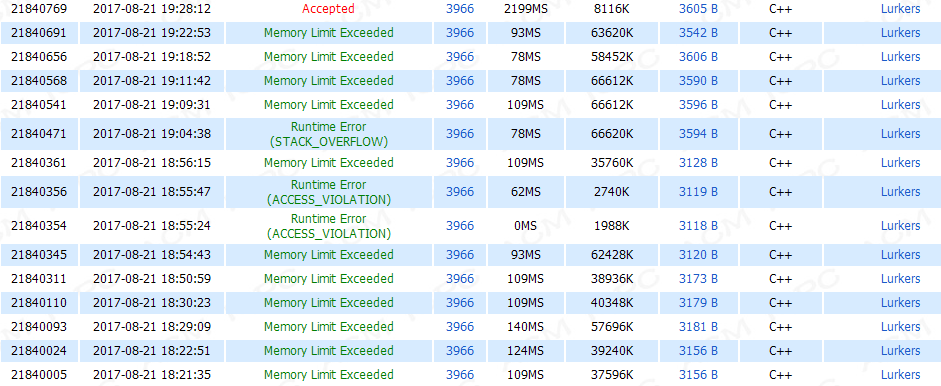Time Limit: 10000/3000 MS (Java/Others) Memory Limit: 32768/32768 K (Java/Others)
Total Submission(s): 12673 Accepted Submission(s):
3394
Problem Description
Our protagonist is the handsome human prince Aragorn
comes from The Lord of the Rings. One day Aragorn finds a lot of enemies who
want to invade his kingdom. As Aragorn knows, the enemy has N camps out of his
kingdom and M edges connect them. It is guaranteed that for any two camps, there
is one and only one path connect them. At first Aragorn know the number of
enemies in every camp. But the enemy is cunning , they will increase or decrease
the number of soldiers in camps. Every time the enemy change the number of
soldiers, they will set two camps C1 and C2. Then, for C1, C2 and all camps on
the path from C1 to C2, they will increase or decrease K soldiers to these
camps. Now Aragorn wants to know the number of soldiers in some particular camps
real-time.
Input
Multiple test cases, process to the end of
input.
For each case, The first line contains three integers N, M, P which means there will be N(1 ≤ N ≤ 50000) camps, M(M = N-1) edges and P(1 ≤ P ≤ 100000) operations. The number of camps starts from 1.
The next line contains N integers A1, A2, ...AN(0 ≤ Ai ≤ 1000), means at first in camp-i has Ai enemies.
The next M lines contains two integers u and v for each, denotes that there is an edge connects camp-u and camp-v.
The next P lines will start with a capital letter 'I', 'D' or 'Q' for each line.
'I', followed by three integers C1, C2 and K( 0≤K≤1000), which means for camp C1, C2 and all camps on the path from C1 to C2, increase K soldiers to these camps.
'D', followed by three integers C1, C2 and K( 0≤K≤1000), which means for camp C1, C2 and all camps on the path from C1 to C2, decrease K soldiers to these camps.
'Q', followed by one integer C, which is a query and means Aragorn wants to know the number of enemies in camp C at that time.
For each case, The first line contains three integers N, M, P which means there will be N(1 ≤ N ≤ 50000) camps, M(M = N-1) edges and P(1 ≤ P ≤ 100000) operations. The number of camps starts from 1.
The next line contains N integers A1, A2, ...AN(0 ≤ Ai ≤ 1000), means at first in camp-i has Ai enemies.
The next M lines contains two integers u and v for each, denotes that there is an edge connects camp-u and camp-v.
The next P lines will start with a capital letter 'I', 'D' or 'Q' for each line.
'I', followed by three integers C1, C2 and K( 0≤K≤1000), which means for camp C1, C2 and all camps on the path from C1 to C2, increase K soldiers to these camps.
'D', followed by three integers C1, C2 and K( 0≤K≤1000), which means for camp C1, C2 and all camps on the path from C1 to C2, decrease K soldiers to these camps.
'Q', followed by one integer C, which is a query and means Aragorn wants to know the number of enemies in camp C at that time.
Output
For each query, you need to output the actually number
of enemies in the specified camp.
Sample Input
3 2 5
1 2 3
2 1
2 3
I 1 3 5
Q 2
D 1 2 2
Q 1
Q 3
Sample Output
7
4
8
Hint
1.The number of enemies may be negative.
2.Huge input, be careful.
树剖裸题
然而。。。

TM我输入顺序反了!我TM竟然还把样例过了!
心疼我是个智障
#include <cstring> #include <cstdio> #define N 50005 struct Segment { int l,r,sum,flag; }tr[N*4]; int n,m,p,tdis[N],belong[N],top[N],siz[N],dad[N],dep[N],next[N*2],to[N*2],head[N],cnt,dfn[N],tim; inline void init() { cnt=tim=0; memset(to,0,sizeof(to)); memset(tr,0,sizeof(tr)); memset(top,0,sizeof(top)); memset(siz,0,sizeof(siz)); memset(dfn,0,sizeof(dfn)); memset(dep,0,sizeof(dep)); memset(next,0,sizeof(next)); memset(head,0,sizeof(head)); memset(tdis,0,sizeof(tdis)); memset(belong,0,sizeof(belong)); } inline void ins(int u,int v) { next[++cnt]=head[u];to[cnt]=v;head[u]=cnt; next[++cnt]=head[v];to[cnt]=u;head[v]=cnt; } void dfs1(int x) { dep[x]=dep[dad[x]]+1; siz[x]=1; for(int i=head[x];i;i=next[i]) { if(dad[x]!=to[i]) { dad[to[i]]=x; dfs1(to[i]); siz[x]+=siz[to[i]]; } } } void dfs2(int x) { int pos=0; if(!top[x]) top[x]=x; dfn[++tim]=x;belong[x]=tim; for(int i=head[x];i;i=next[i]) if(dad[x]!=to[i]&&siz[pos]<siz[to[i]]) pos=to[i]; if(pos) top[pos]=top[x],dfs2(pos); for(int i=head[x];i;i=next[i]) if(dad[x]!=to[i]&&to[i]!=pos) dfs2(to[i]); } inline void pushup(int k) {tr[k].sum=tr[k<<1].sum+tr[k<<1|1].sum;} void build(int k,int l,int r) { tr[k].l=l;tr[k].r=r; if(l==r) { tr[k].sum=tdis[dfn[l]]; return; } int mid=(l+r)>>1; build(k<<1,l,mid); build(k<<1|1,mid+1,r); pushup(k); } inline void swap(int &m,int &n) { int tmp=n; n=m; m=tmp; } inline void pushdown(int k) { tr[k<<1].flag+=tr[k].flag; tr[k<<1|1].flag+=tr[k].flag; tr[k<<1].sum+=tr[k].flag*(tr[k<<1].r-tr[k<<1].l+1); tr[k<<1|1].sum+=tr[k].flag*(tr[k<<1|1].r-tr[k<<1|1].l+1); tr[k].flag=0; } int query(int k,int t) { if(tr[k].l==tr[k].r) return tr[k].sum; if(tr[k].flag) pushdown(k); int mid=(tr[k].l+tr[k].r)>>1; if(t<=mid) return query(k<<1,t); else return query(k<<1|1,t); } void Tmodify(int k,int l,int r,int v) { if(tr[k].l==l&&tr[k].r==r) { tr[k].sum+=v*(r-l+1); tr[k].flag+=v; return; } if(tr[k].flag) pushdown(k); int mid=(tr[k].l+tr[k].r)>>1; if(l>mid) Tmodify(k<<1|1,l,r,v); else if(r<=mid) Tmodify(k<<1,l,r,v); else Tmodify(k<<1,l,mid,v),Tmodify(k<<1|1,mid+1,r,v); pushup(k); } inline void Cmodify(int x,int y,int v) { for(;top[x]!=top[y];x=dad[top[x]]) { if(dep[top[x]]<dep[top[y]]) swap(x,y); Tmodify(1,belong[top[x]],belong[x],v); } if(dep[x]<dep[y]) swap(x,y); Tmodify(1,belong[y],belong[x],v); } int main() { for(;scanf("%d%d%d",&n,&m,&p)!=EOF;) { init(); for(int i=1;i<=n;++i) scanf("%d",&tdis[i]); for(int x,y;m--;) { scanf("%d%d",&x,&y); ins(x,y); } dfs1(1); dfs2(1); char opt[5]; build(1,1,n); for(int x,y,z;p--;) { scanf("%s",opt); if(opt[0]=='I') { scanf("%d%d%d",&x,&y,&z); Cmodify(x,y,z); } else if(opt[0]=='D') { scanf("%d%d%d",&x,&y,&z); Cmodify(x,y,-z); } else { scanf("%d",&x); printf("%d ",query(1,belong[x])); } } } return 0; }